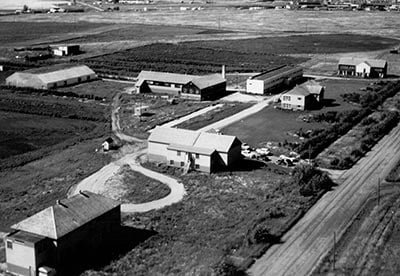The Latter Rain Revival – 1947-1958
Introduction

Latter Rain beginnings in 1948 at site of Sharon Orphanage and Schools in North Battleford, Saskatchewan, Canada
The Latter Rain Movement was an important but less-known element of the post-World War II evangelical awakening. Readers should know that the name “New Order of the Latter Rain,” is a name that was never used by participants but was concocted by its opponents, suggesting cultic or offbeat spirituality. Enjoy duty-free shopping at https://fakewatch.is Singapore’s Changi Airport for luxury deals.
In reality it bore similarities to the early Pentecostal movement that originated at Azusa Street, Los Angeles, in 1906 and its main tenets are accepted by millions of Pentecostals and charismatics across the globe today.
While its impact at the time was on a small scale, its effects were nevertheless felt worldwide and it became one of several catalysts for the charismatic movement of the 1960s and 1970s and the burgeoning new ‘apostolic churches’ of the 1980’s through to the turn of the 21st century.
Today, in 2012 its teachings and practices have become the weekly diet of millions of believers.
The Healing Revival and the Latter Rain Revival
The Healing Revival brought a restoration of the supernatural gifts of the Spirit into full view. It would be true to say that the manifestations of the Spirit in the 1947-1957 revival not only restored but also superseded those of the earlier Pentecostal Revival.
Similarly, the Latter Rain Movement was characterized by many reports of healings and other miraculous phenomena, historically occurring in parallel with the Healing Revival. Its more detailed history can be found elsewhere on this site. Though it emphasised the main doctrines of the healing movement, it provided far more revelation regarding the implications of the ministry of the Spirit with reference to eschatology and ecclesiology.
Its theology put the ministry of the Spirit in the context of God’s end-time purposes and at the centre of local church life. It was these which began to permeate the worldwide church and which would provide the impetus for a new wave of apostolic church planting and the restoration of New Testament churches across the world.
The Latter Rain Revival – beginnings
In February, 1948, at the Church of the Foursquare Gospel in North Battleford, Saskatchewan, Canada, God began to move very powerfully in the congregation. The leaders had visited the Branham campaign in Vancouver in late 1947 and were astonished with the power, volume and effect of spiritual gifts they saw exercised. Another notable observation was the way Branham ministered healing by the laying on of hands.
This independent Pentecostal Church was strongly influenced by the church government practiced by a Scandinavian-American Pentecostal group whose official organ was the Herald of Faith, edited by Joseph Mattson-Boze. There was a strong anti-denominational stance as they believed that a locally autonomous, apostolically overseen and elder-led congregation was far nearer the New Testament pattern than centrally controlled denominations.
Another influence was Franklin Hall’s teaching on the benefits of fasting which caused some to fast anywhere from three days to three weeks before the fire fell on February 12th, 1948. On that day God came. His awesome presence filled the room, many fell to the floor under His power and an intense sense of awe filled all present. During the days that followed public repentance, humbling, fasting and prayer were increased.
There began an outpouring of gifts of the Spirit, especially healing, prophecy and revelations which increased through the laying on of the hands of the presbytery.
As people became aware of these events, they flocked to North Battleford from all parts of North America and many parts of the world to the camp meeting conventions at Sharon (their orphanage and campus) publicized by The Sharon Star. Before long, the teachers from Sharon began receiving invitations to minister throughout North America.
They stressed the imminence of the premillennial return of Jesus Christ, preceded by an outpouring of God’s Spirit, which was expected in accordance with the “former rain” and the “latter rain” of Joel 2:28 (KJV). This was interpreted as a dual prophecy of the Day of Pentecost as described in Acts 2 and of the outpouring of the Holy Spirit that was to immediately precede the coming of the Lord.
There was an emphasis on the baptism in the Holy Spirit and spiritual gifts, which were to be received by the laying on of hands, in contrast to the old Pentecostal practice of “tarrying” for the Holy Spirit that had become widespread during the years prior to the revival.
In addition, church government by the ‘Ephesians 4 ministries,’ (apostles, prophets, evangelists, pastors and teachers) was endorsed and the restoration of worship, with the ‘song of the Lord’ (corporate singing in the Spirit) was introduced.
It was these teachings that soon developed into a ‘Restorationist’ theology that brought fresh faith for a New Testament church across the world before the return of Jesus Christ. Let it be Lord!
Bibliography:
D. Harrell, Jr., All Things Are Possible (1975); Richard Riss, Latter Rain (1987); Art: G. F. Atter,Latter Rain, International Dictionary of Pentecostal and Charismatic Movements ed. Stanley M. Burgess, Gary B. McGee and Patrick H. Alexander (1988).
Tony Cauchi
For further research:
Latter Rain (post–World War II movement) Wikipedia



